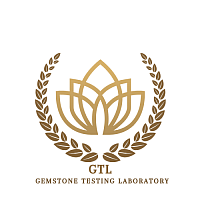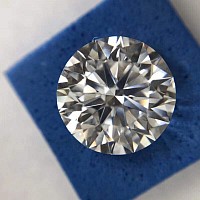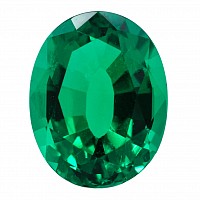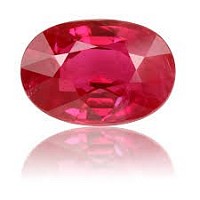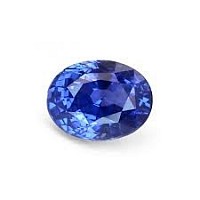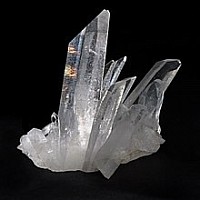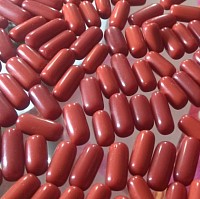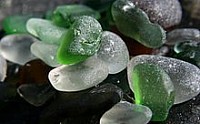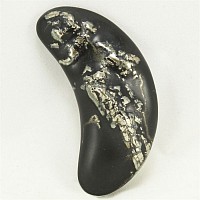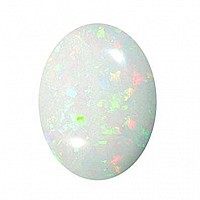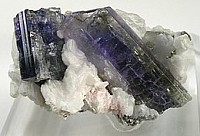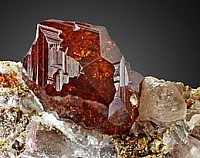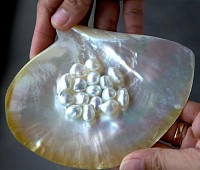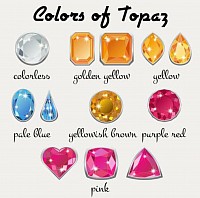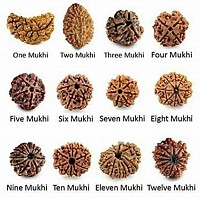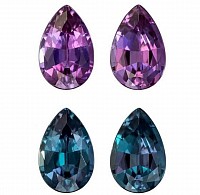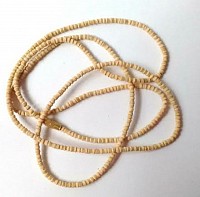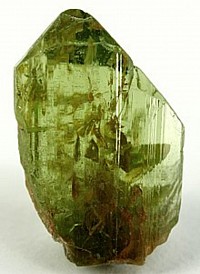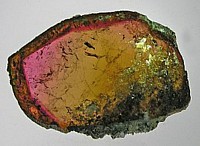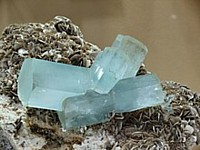Diamond is a solid form of carbon with a diamond cubic crystal structure. At room temperature and pressure it is metastable and graphite is the stable form, but diamond almost never converts to graphite. Diamond is renowned for its superlative physical qualities, most of which originate from the strong covalent bonding between its atoms. In particular, it has the highest hardness and thermal conductivity of any bulk material. Those properties determine the major industrial applications of diamond in cutting and polishing tools and the scientific applications in diamond knives and diamond anvil cells.
Category- Native minerals
Formula- (repeating unit)C
Strunz classification- 1.CB.10a
Dana classification- 1.3.6.1
Crystal system- CubicCrystal class
Hexoctahedral (m3m)
H-M symbol: (4/m 3 2/m)
Emerald is a precious gemstone and a variety of the mineral beryl (Be3Al2(SiO3)6) colored green by trace amounts of chromium and sometimes vanadium.[2] Beryl has a hardness of 7.5–8 on the Mohs scale.[2] Most emeralds are highly included,[3] so their toughness (resistance to breakage) is classified as generally poor. Emerald is a cyclosilicate.
Category- Beryl variety
Formula(repeating unit)- Be3Al2(SiO3)6
Crystal system- Hexagonal (6/m 2/m 2/m)
Space group: P6/mсc Space group
(6/m 2/m 2/m) – dihexagonal dipyramidal
Unit cell- a = 9.21 Å, c = 9.19 Å; Z = 2
A ruby is a pink to blood-red colored gemstone, a variety of the mineral corundum (aluminium oxide). Other varieties of gem-quality corundum are called sapphires. Ruby is one of the traditional cardinal gems, together with amethyst, sapphire, emerald, and diamond. The word ruby comes from ruber, Latin for red. The color of a ruby is due to the element chromium.
Category- Oxide mineral variety
Formula(repeating unit)- aluminium oxide with chromium, Al2O3:Cr
Crystal system- Trigonal
Crystal class- Hexagonal scalenohedral (3m)
H-M symbol: (3 2/m)
Space group- R3c[1]
Sapphire is a precious gemstone, a variety of the mineral corundum, an aluminium oxide (α-Al2O3). It is typically blue, but natural "fancy" sapphires also occur in yellow, purple, orange, and green colors; "parti sapphires" show two or more colors. The only color which sapphire cannot be is red – as red colored corundum is called ruby,[ another corundum variety. Pink colored corundum may be either classified as ruby or sapphire depending on locale. This variety in color is due to trace amounts of elements such as iron, titanium, chromium, copper, or magnesium.
Category- Oxide mineral
Formula(repeating unit)- Aluminium oxide, Al2O3
Crystal system- Trigonal
Crystal class- Hexagonal scalenohedral (3m)
H-M symbol: (32/m)
Space group- R3c
Quartz is a mineral composed of silicon and oxygen atoms in a continuous framework of SiO4 silicon–oxygen tetrahedra, with each oxygen being shared between two tetrahedra, giving an overall chemical formula of SiO2. Quartz is the second most abundant mineral in Earth's continental crust, behind feldspar.
Category- oxide mineral
Formula
(repeating unit)- SiO2
Strunz classification- 4.DA.05 (Oxides)
Dana classification- 75.01.03.01 (tectosilicates)
Crystal system- α-quartz: trigonal
β-quartz: hexagonal
Crystal class- α-quartz: trapezohedral (class 3 2); β-quartz: trapezohedral (class 6 2 2)[3]
Unit cell- a = 4.9133 Å, c = 5.4053 Å; Z=3
Corals are marine invertebrates in the class Anthozoa of phylum Cnidaria. They typically live in compact colonies of many identical individual polyps. The group includes the important reef builders that inhabit tropical oceans and secrete calcium carbonate to form a hard skeleton.
Kingdom:Animalia
Phylum:Cnidaria
Class:Anthozoa Ehrenberg, 1831
Sea glass and beach glass are similar but come from two different types of water. "Sea glass" is physically and chemically weathered glass found on beaches along bodies of salt water. These weathering processes produce natural frosted glass."Genuine sea glass" can be collected as a hobby and is used for decoration, most commonly in jewelry. "Beach glass" comes from fresh water and in most cases has a different pH balance and a less frosted appearance than sea glass. Sea glass takes 20 to 40 years, and sometimes as much as 100 years, to acquire its characteristic texture and shape. Sometimes also colloquially referred to as "Drift glass" from the longshore drift process that forms the smooth edges. In practice, the two terms are used interchangeably.
Dragon Bone Stone, is Taiwan’slocal special mineral. Dragon Bone Stone’s color is mainly bronze due to the rich copper minerals it contains, which are oxidized over the time.
Taiwan is one of the pacific islands located on the Pacific Volcano Zone. In its history, the island had frequent geothermal and volcano activities. Geothermal activity causes Taiwan’s subterranean strata to jostle one another under conditions of extreme high pressure and heat. Many famous gem mines were born in this way. For example, Taiwan’s Hualien county produces high quality and quantity marble and opal
Opal is a hydrated amorphous form of silica (SiO2·nH2O); its water content may range from 3 to 21% by weight, but is usually between 6 and 10%. Because of its amorphous character, it is classed as a mineraloid, unlike crystalline forms of silica, which are classed as minerals. It is deposited at a relatively low temperature and may occur in the fissures of almost any kind of rock, being most commonly found with limonite, sandstone, rhyolite, marl, and basalt. Opal is the national gemstone of Australia.
Tanzanite is the blue and violet variety of the mineral zoisite (a calcium aluminium hydroxyl sorosilicate), caused by small amounts of vanadium, belonging to the epidote group. Tanzanite is only found in Tanzania, in a very small mining area (approximately 7 km (4.3 mi) long and 2 km (1.2 mi) wide) near the Merelani Hills.
Tanzanite is noted for its remarkably strong trichroism, appearing alternately blue, violet and burgundy depending on crystal orientation. Tanzanite can also appear differently when viewed under different lighting conditions. The blues appear more evident when subjected to fluorescent light and the violet hues can be seen readily when viewed under incandescent illumination. In its rough state tanzanite is colored a reddish brown to clear, and it requires heat treatment to remove the brownish "veil" and bring out the blue violet of the stone.
Rhodolite is a varietal name for rose-pink to red mineral pyrope, a species in the garnet group. It was first described from Cowee Valley, Macon County, North Carolina.The name is derived from the Greek "rhodon" for "rose-like", in common with other pink mineral types (e.g. rhodochrosite, rhodonite). This coloration, and the commonly inclusion-free nature of garnet from this locality, has led to rhodolite being used as a gemstone. Rhodolite like other varietal names is not officially recognized as a mineralogical term, but rather used as an accepted trade name.
Garnets ( /ˈɡɑːrnɪt/) are a group of silicate minerals that have been used since the Bronze Age as gemstones and abrasives.
All species of garnets possess similar physical properties and crystal forms, but differ in chemical composition. The different species are pyrope, almandine, spessartine, grossular (varieties of which are hessonite or cinnamon-stone and tsavorite), uvarovite and andradite. The garnets make up two solid solution series: pyrope-almandine-spessartine and uvarovite-grossular-andradite.
Jade refers to an ornamental mineral, mostly known for its green varieties. It can refer to either of two different minerals: nephrite, a silicate of calcium and magnesium, or jadeite, a silicate of sodium and aluminium.
Jade is featured prominently in ancient Asian art, but also has an important place in many other cultures.
A pearl is a hard, glistening object produced within the soft tissue (specifically the mantle) of a living shelled mollusk or another animal, such as fossil conulariids. Just like the shell of a mollusk, a pearl is composed of calcium carbonate (mainly aragonite or a mixture of aragonite and calcite) in minute crystalline form, which has deposited in concentric layers. The ideal pearl is perfectly round and smooth, but many other shapes, known as baroque pearls, can occur. The finest quality of natural pearls have been highly valued as gemstones and objects of beauty for many centuries. Because of this, pearl has become a metaphor for something rare, fine, admirable and valuable.
Topaz is a silicate mineral of aluminium and fluorine with the chemical formula Al2SiO4(F,OH)2. It is used as a gemstone in jewelry and other adornments. Common topaz in its natural state is colorless, though trace element impurities can make it pale blue or golden brown to yellow orange. Topaz is often treated with heat or radiation to make it a deep blue, reddish-orange, pale green, pink, or purple.
Rudraksha (IAST: rudrākṣa) refers to a stonefruit, the dried stones of which are used as prayer beads by Hindus (especially Shaivas), as well as by Buddhists and Sikhs.When they are ripe, rudraksha stones are covered by an inedible blue outer fruit so they are sometimes called "blueberry beads". The rudraksha stones are produced by several species of large, evergreen, broad-leaved tree in the genus Elaeocarpus, the principal species of which is Elaeocarpus ganitrus. The stones are associated with the Hindu deity Shiva and are commonly worn for protection and for chanting mantras such as Om Namah Shivaya (Sanskrit: ॐ नमः शिवाय; Om Namaḥ Śivāya). The stones are primarily sourced from India, Indonesia, and Nepal for jewellery and malas (garlands); they are valued similarly to semi-precious stones.[citation needed] Various meanings and interpretations are attributed to rudraksha stones with different numbers of "faces" (Sanskrit: मुख, romanized: mukha, lit. 'face') or locules, and rare or unique stones are highly prized and valued.
Alexandrite is a rare stone from the Chrysoberyl mineral family that exhibits sharp change of color. This highly valued gemstone is used in crystal healing therapies and possesses strong metaphysical powers
Alexandrite Stone Benefits
Alexandrite stone is revered for its strong healing properties, metaphysical powers, and is extensively used in crystal healing therapies. It is known to maintain a perfect balance between physical world and spiritual world. There are some other exceptional benefits of wearing this lovely June birthstone Alexandrite.
Physical Health Benefits: Alexandrite stone is known to have splendid medical benefits. It is quite beneficial for people who are suffering from issues and ailments related to the nervous system and reproductive organs. This gemstone regenerates neurological tissues and soothes inflammation in neck muscles. It helps to ease the symptoms of leukaemia and strengthens the pineal and pituitary glands. The powerful detoxifying action of real Alexandrite stone stimulates the liver so that it will work at its peak performance.
Emotional Healing Benefits: Natural Alexandrite stone encourages the wearer to listen to his/her feelings and helps to achieve emotional maturity. It strengthens willpower and encourages the wearer to accept change and emotional issues that go with that change. Alexandrite crystal is particularly useful for Chakra healing therapies and balances the Heart Chakra. It calms the feelings of being lost and develops interest in pursuing a fulfilling career.
Channelizes Positive Energy: Alexandrite birthstone channelizes positive thoughts and wards off negativity from mind and body. It boosts self esteem, brings good luck, and is considered to be a very positive omen. It has a powerful and protective charm that keeps the wearer safe and protected from any harm and negative energy.
Boosts Creativity & Intellectual Powers: Due to its pleasant blue-green hue, many Astrologers believed that Alexandrite gemstone is ruled by planet Mercury. This alluring gemstone negates the harmful effects of Mercury and encourages the wearer to deal with confusion, creative blocks, and poor judgement skills. Alexandrite stone benefits by enhancing the wearer’s intellectual abilities which ultimately encourages to take strong and fruitful decisions in life.
Promotes Professional Success: Among the various benefits of Alexandrite stone, success in business and career is one of the most significant benefits. It benefits the wearer to overcome professional instability and struggle for recognition. Fame, good luck, and prosperity are believed to be bestowed on the wearer of this rare gemstone.
Ocimum tenuiflorum [or Ocimum sanctum L. commonly known as holy basil, tulsi or tulasi, is an aromatic perennial plant in the family Lamiaceae. It is native to the Indian subcontinent and widespread as a cultivated plant throughout the Southeast Asian tropics.
Tulsi is cultivated for religious and traditional medicine purposes, and also for its essential oil. It is widely used as a herbal tea, commonly used in Ayurveda, and has a place within the Vaishnava tradition of Hinduism, in which devotees perform worship involving holy basil plants or leaves. Tulsi is one of the best plants for purifying indoor air quality as it absorbs many toxic chemicals like xylene, formaldehyde and benzene.
Peridot (/ˈpɛr.ɪˌdɒt, -ˌdoʊ/ PERR-ih-dot, -doh), (the origin of Peridot is uncertain) sometimes called chrysolite, is defined as a deep yellowish-green transparent variety of olivine which is used as a gem. Peridot is one of the few gemstones that only occurs in one color. This color coming from the iron contents within the structure of the gem.
Tourmaline (/ˈtʊərməlɪn, -ˌlin/ TOOR-mə-lin, -leen) is a crystalline silicate mineral group in which boron is compounded with elements such as aluminium, iron, magnesium, sodium, lithium, or potassium. Tourmaline is a gemstone and can be found in a wide variety of colors.
Aquamarine is a pale-blue to light-green variety of beryl. The color of aquamarine can be changed by heat. The aquamarine has a chemical composition of Be3Al2Si6O18, also containing Fe2+. It has a hardness of 7.5 to 8. Aquamarine contains no or few noticeable inclusions[7] but it can have inclusions like mica, hematite, or salt-water.
Aquamarine is a common gemstone. However, there is a rarer deep blue variant called maxixe, but its color can fade due to sunlight. The color of maxixe is caused by NO3. Dark-blue maxixe color can be produced in green, pink or yellow beryl by irradiating it with high-energy radiation
